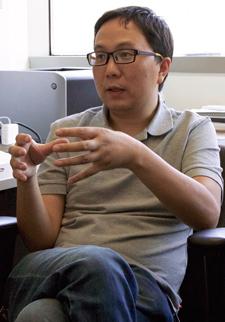- News
21 July 2015
UCLA demos first electroluminescence from multi-layer molybdenum disulphide
The California NanoSystems Institute (CNSI) at University of California Los Angeles (UCLA) has demonstrated the first electroluminescence from multi-layer molybdenum disulphide (MoS2), which could lead to a new class of materials for making LEDs ('Electric-field-induced strong enhancement of electroluminescence in multilayer molybdenum disulfide', Nature Communications 6 7509).
In its single-layer form, molybdenum disulfide is optically active (i.e. it emits light when electric current is run through it or when it is shot with a non-destructive laser). Multi-layer molybdenum disulfide, by contrast, is easier and less expensive to produce, but it is not normally luminescent. In the new study, chemistry and biochemistry professor Xianfeng Duan and first author Dehui Li (a postdoctoral scholar in Duan's lab) created what is claimed to be the first multi-layer molybdenum disulfide device that shows strong luminescence when electrical current is passed through it.
 Picture:
Professor Xiangfeng Duan.
Picture:
Professor Xiangfeng Duan.
"We were trying to make a vertically stacked light-emitting device based on monolayer MoS2, but it was difficult to get the efficiency as high as we wanted," says Duan. "On the other hand, it was rather surprising for us to discover that similar vertical devices made of multi-layer MoS2 somehow showed very strong electroluminescence, which was completely unexpected since the multi-layer MoS2 is generally believed to be optically inactive," he adds. "So we followed this new lead to investigate the underlying mechanism and the potential of multi-layer MoS2 in light-emitting devices."
Duan and his team used the technique of electric-field-induced enhancement, which relocates the electrons from a dark state to a luminescent state, to increase the material's ability to convert electrons into lphotons. Multi-layer MoS2 is hence at least as efficient as monolayer MoS2.
Duan's team is currently applying this approach to similar transition-metal dichalcogenide materials, including tungsten diselenide, molybdenum diselenide and tungsten disulphide, with the goal of helping to create a new generation of LEDs from two-dimensional layered materials that are less expensive and easier to use in manufacturing.
www.nature.com/ncomms/2015/150701/


